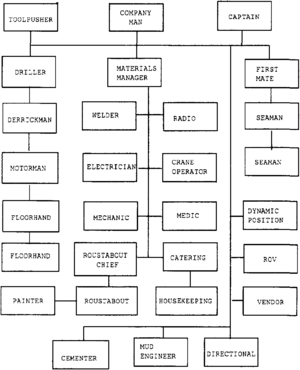Rig personnel
| Development Geology Reference Manual | |

| |
| Series | Methods in Exploration |
|---|---|
| Part | Wellsite methods |
| Chapter | Rig personnel |
| Author | Byram Reed |
| Link | Web page |
| Store | AAPG Store |
Basic rig crew
The type and number of rig personnel is related to the size and complexity of the rig. At the simplest level, a basic rig includes a toolpusher, a driller, a derrickman, a motorman, and a floorhand.
The toolpusher is the senior manager at the rig and is responsible for personnel, parts, and performance. The driller reports directly to the toolpusher and is responsible for the active drilling phase, trips, and the safety of the floor hands. Reporting to the driller are the derrickman, motorman (and lead tong), and floorhand.
The derrickman handles the top end of each stand of pipe during trips. When not tripping pipe, the derrickman is in charge of the circulating system. The motorman keeps the engines and other parts of the rig in working order and functions as the lead tong during trips. The floorhand handles the backup tong in trips and is apprenticed to the senior crew members.
Although the toolpusher stays at the rig 24 hr a day, the crew(s) usually commute and work 8- or 12-hr shifts or tours.
Additional personnel
On large, complex rigs, additional personnel are required. A representive from the client company called the drilling foreman or company man is typically present on the rig. The company representive is in charge of all drilling operations at the wellsite, including safety.
On offshore and remote land locations, rig personnel stay at the wellsite. Additional personnel that provide services such as welding and electrical work are also housed at the wellsite, along with personnel to house, feed, and care for the crew. An example of the general organization required to run a complex operation is given in Figure 1. Each of the positions shown represents at least two people (assuming 12-hr tours), with a five- to six-person catering crew and additional seamen on offshore rigs.
See also
- Drilling problems
- Mudlogging: drill cuttings analysis
- Introduction to wellsite methods
- Wellbore trajectory
- Conventional coring
- Drilling fluid
- Land rigs
- Wellsite math
- Core handling
- Mudlogging: equipment, services, and personnel
- Core alteration and preservation
- Wellsite safety
- Sidewall coring
- Show evaluation
- Rate of penetration
- Mudlogging: the mudlog
- Well planning
- Pressure detection
- Drill stem testing
- Measurement while drilling
- Offshore rigs
- Fishing
- Core orientation
- Mudlogging: gas extraction and monitoring
